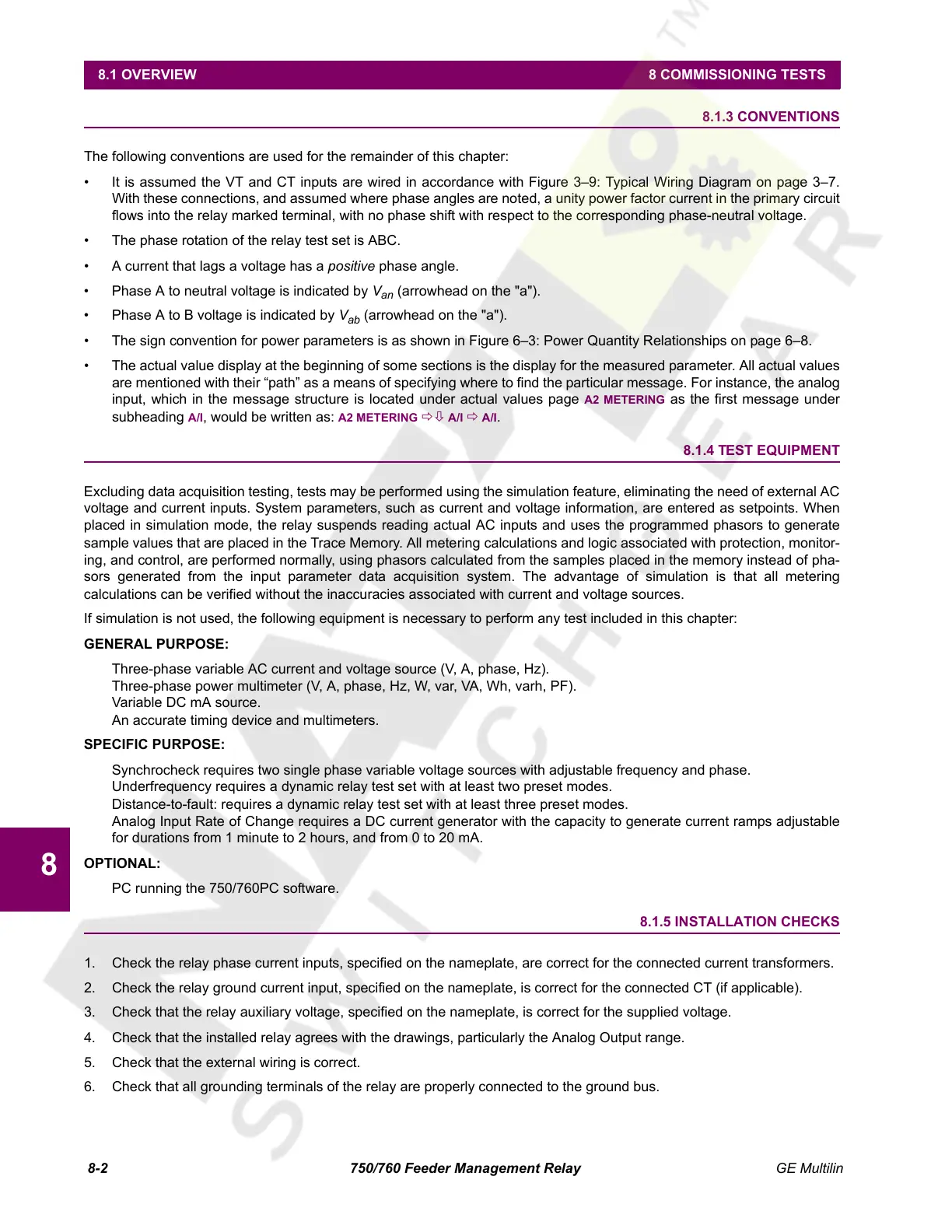8-2 750/760 Feeder Management Relay GE Multilin
8.1 OVERVIEW 8 COMMISSIONING TESTS
8
8.1.3 CONVENTIONS
The following conventions are used for the remainder of this chapter:
• It is assumed the VT and CT inputs are wired in accordance with Figure 3–9: Typical Wiring Diagram on page 3–7.
With these connections, and assumed where phase angles are noted, a unity power factor current in the primary circuit
flows into the relay marked terminal, with no phase shift with respect to the corresponding phase-neutral voltage.
• The phase rotation of the relay test set is ABC.
• A current that lags a voltage has a positive phase angle.
• Phase A to neutral voltage is indicated by V
an
(arrowhead on the "a").
• Phase A to B voltage is indicated by V
ab
(arrowhead on the "a").
• The sign convention for power parameters is as shown in Figure 6–3: Power Quantity Relationships on page 6–8.
• The actual value display at the beginning of some sections is the display for the measured parameter. All actual values
are mentioned with their “path” as a means of specifying where to find the particular message. For instance, the analog
input, which in the message structure is located under actual values page A2 METERING as the first message under
subheading
A/I, would be written as: A2 METERING ÖØ A/I Ö A/I.
8.1.4 TEST EQUIPMENT
Excluding data acquisition testing, tests may be performed using the simulation feature, eliminating the need of external AC
voltage and current inputs. System parameters, such as current and voltage information, are entered as setpoints. When
placed in simulation mode, the relay suspends reading actual AC inputs and uses the programmed phasors to generate
sample values that are placed in the Trace Memory. All metering calculations and logic associated with protection, monitor-
ing, and control, are performed normally, using phasors calculated from the samples placed in the memory instead of pha-
sors generated from the input parameter data acquisition system. The advantage of simulation is that all metering
calculations can be verified without the inaccuracies associated with current and voltage sources.
If simulation is not used, the following equipment is necessary to perform any test included in this chapter:
GENERAL PURPOSE:
Three-phase variable AC current and voltage source (V, A, phase, Hz).
Three-phase power multimeter (V, A, phase, Hz, W, var, VA, Wh, varh, PF).
Variable DC mA source.
An accurate timing device and multimeters.
SPECIFIC PURPOSE:
Synchrocheck requires two single phase variable voltage sources with adjustable frequency and phase.
Underfrequency requires a dynamic relay test set with at least two preset modes.
Distance-to-fault: requires a dynamic relay test set with at least three preset modes.
Analog Input Rate of Change requires a DC current generator with the capacity to generate current ramps adjustable
for durations from 1 minute to 2 hours, and from 0 to 20 mA.
OPTIONAL:
PC running the 750/760PC software.
8.1.5 INSTALLATION CHECKS
1. Check the relay phase current inputs, specified on the nameplate, are correct for the connected current transformers.
2. Check the relay ground current input, specified on the nameplate, is correct for the connected CT (if applicable).
3. Check that the relay auxiliary voltage, specified on the nameplate, is correct for the supplied voltage.
4. Check that the installed relay agrees with the drawings, particularly the Analog Output range.
5. Check that the external wiring is correct.
6. Check that all grounding terminals of the relay are properly connected to the ground bus.
Courtesy of NationalSwitchgear.com

